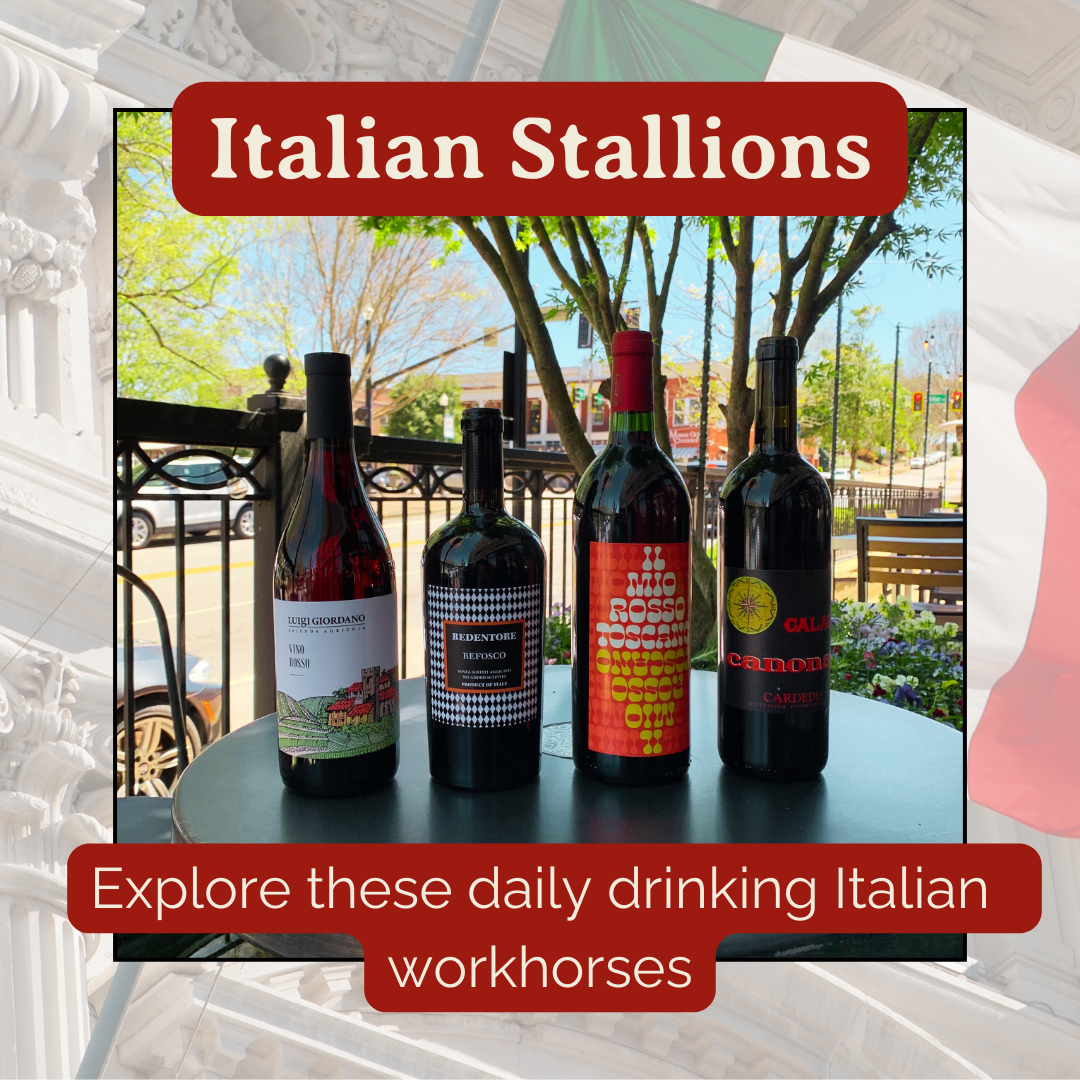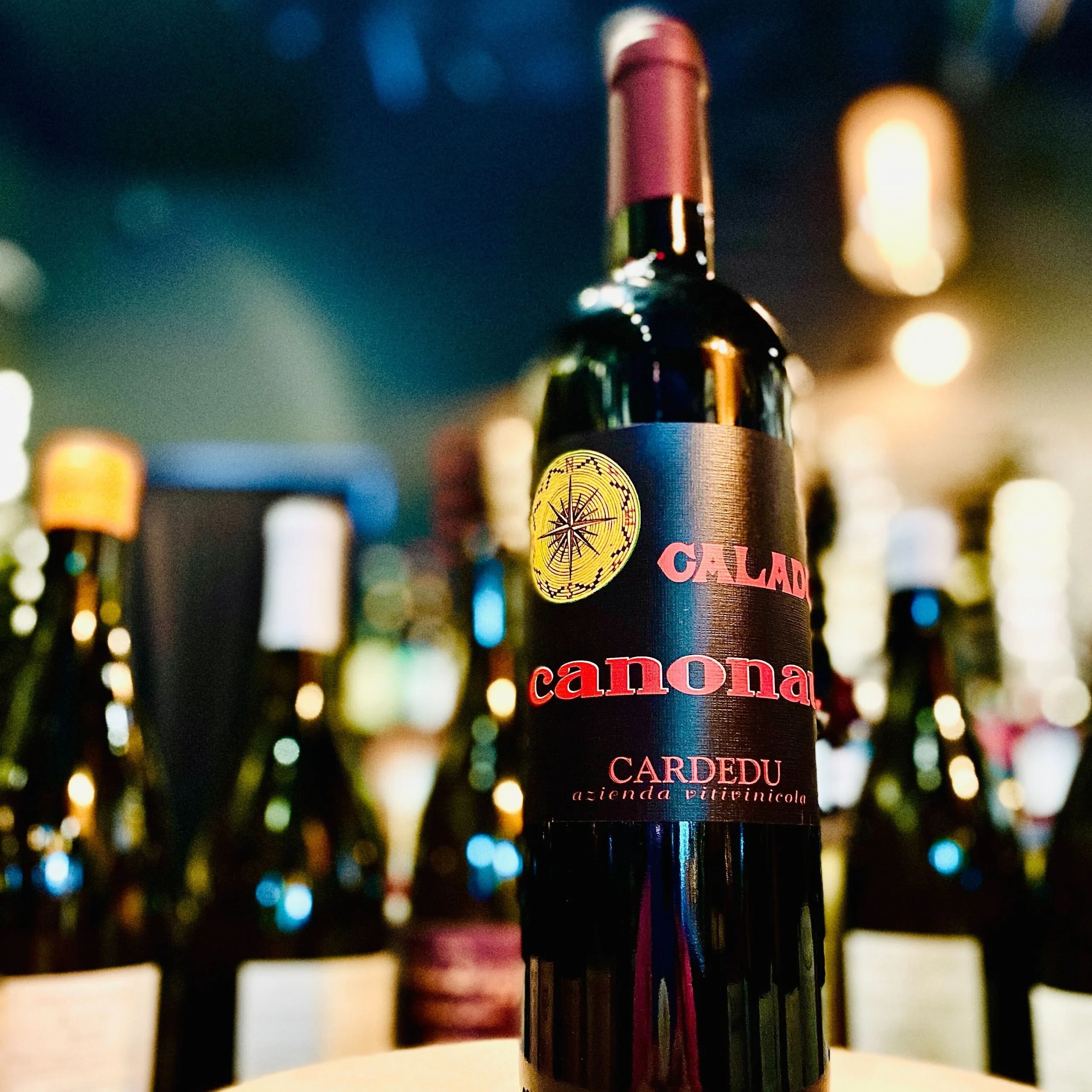Italian Stallions
These wines are all stunners and drink way outside their price point. Come taste through this lineup of Italian Workhorses.
Luigi Giordano ‘Vino Rosso’
Grapes: 80% Nebbiolo, 20% Arneis
Place: Barbaresco - Italy
Process: The Arneis grapes are destemmed and pressed gently to ensure preservation of aromatics before beginning fermentation at a controlled temperature. The Nebbiolo grapes are harvested two weeks later, at which point they are also destemmed and pressed gently. The cap of the Arneis tank—complete with skins, seeds, and actively fermenting must—is then added to the Nebbiolo. Fermented under temperature control and daily pumpover, the wine spends 8-10 days on the skins and then completes malolactic fermentation in stainless-steel tanks. After completing fermentation, the wine ages for 2 months in large Slavonian botte followed by at least 3 months in bottle prior to release.
Family: A stone’s throw from the village center of Barbaresco, the winery was established by Giovanni Giordano in the 1930s during a time of profound crisis in the Italian wine world. After a period of growing and selling grapes, Giovanni’s son, Luigi, made the bold decision to vinify his own fruit, bottling the first wine under his own label in 1958. For an independent grower like Luigi to bottle his own wine at a time when plans to establish an official appellation in Barbaresco were only in their infancy was nearly unthinkable. Today’s winery remains a spirited family effort, driven by the shared vision of Luigi himself, his daughter Laura, and his grandson Matteo. Together, they produce timeless wines from vineyards planted in some of Barbaresco’s most prestigious crus, including Asili and Montestefano. Another Barbaresco bottling from the cru of Cavanna showcases the winery’s elegant, hands-off style of winemaking and represents the only single-vineyard bottling of its kind.
Bottle: $25 | Glass: $11
Redentore
Grapes: 100% Refosco
Place: Veneto - Italy
Process: After harvest the grapes are brought to the winery for destemming and crushing and then a maceration for 10-15 days in special vessels at the temperature of 25-28°C, with frequent pumping over. After this period the wine is taken out and ends its fermentation exclusively with wild yeasts at controlled temperature in stainless steel vats. After malo-lactic fermentation the wine matures for some months on its noble lees in barrique at a controlled temperature.
Redentore Refosco pays tribute to one of the most treasured festivities of Venice, the “Festa del Redentore”. Every third weekend of July Venetians celebrate with an immense fireworks display and sumptuous dinners as the harbor fills with boats. This wine presents hints of blackberry, licorice, melted dark chocolate and sandalwood; it is a dry, warm and full-bodied wine, with soft tannins and a long-lasting aftertaste. Ideal with hearty meat dishes, poultry stews and grilled vegetables, especially wild mushrooms.
Family: The De Stefani family has been producing wines in the Veneto region in Italy for five generations. The "Redentore" wines are obtained with the philosophy that characterizes the way we operate: organic and biodynamic principles in viticulture, energy produced with solar panels, vegan principles, vinification with indigenous yeasts and no sulphites added.
The grapes come from vineyards of the Piave valley and the Conegliano Valdobbiadene hills, a Unesco World Heritage site, north of Venice. The climate, warm during the day and cool at night, the soil rich in clay and minerality, the proximity to the Adriatic Sea and to the Dolomites mountains (Alps) are key factors to offer fruity and fresh wines, with great personality.
Redentore means redeemer: freedom from the plague that struck Venice between 1575 and 1577. It evokes one of the most traditional festivals, the Redentore Festival. Every third weekend in July the Venetians celebrate deliverance from the plague with a spectacular fireworks display and sumptuous dinners as the San Marco harbour fills with boats.
Bottle: $25 | Glass: $11
IL Mio
Grapes: 90% Sangiovese + 10% Other
Place: Tuscany - Italy
Process: A selection from Estate vineyards, 1.2 hectares. Montelupo Fiorentino, just north of the Classico zone. 250m above sea level. Up to 25yr old vines. grown in a mixture of sand and red clay. 10% of the wine sees whole cluster carbonic maceration. Temperature-controlled fermentation for 7-9 days in stainless steel. Combined before 6 mo. aging in concrete and steel. 800 cases produced. Light sulfites before bottling Bentonyte Clay (Vegan) Native Yeasts ORGANIC (not certified)
Family: Alejandro Ortiz spent a Spring in Rome in his late twenties, where he lived in a small apartment with no kitchen in the heart of the Campo Marso. While a stone's throw for the majestic Piazza Navona and the Trevi Fountain, the local narrow streets which snaked their way through the old quarter were full of small, busy trattorias serving mostly locals, seven days a week. He became one of those 'locals' and fell in love with many things, but especially the fresh, hearty-but-quaffable, pitchers of delicious red wine ubiquitous in every eatery. Who made it? Who knows. Where is it from? Maybe Umbria, maybe Tuscany. What is it? Not sure. Is it good? It's delicious!
Il Mio was the first wine project. He wanted to re-create that style of red that was seared onto his heart long ago in Rome's winding streets. First and foremost it's a food wine. Drinkable yes, but not just juice, it needs to have a little bit of tannin. It must be fresh. It must be a delicious all-purpose-trattoria red. It's the wine from his memories, hailing from Tuscany, a venerable red: Il Mio Rosso Toscano and your Tuscan red.
Origen Selections partnered with a fifth generation family-ran historic estate in the heart of the Chianti region and were able to pick, ferment, age and bottle at the estate.
Bottle: $27 | Glass: $12
Cardedu ‘Caladu’
Grapes: Cannonau a.k.a. Grenache
Place: Sardinia - Italy
Process: The grapes come from estate vineyards locatied from 80 m / 263 ft to 140 m / 460 ft. Sandy loam soil from decomposed pink granite are perfect for the grape Cannonau. All of the vines are at least 15 years old and are grown on the low espalier trellis system. Grapes are hand harvested at the end of September.
In the cellar only native yeasts are used for fermentation. The wine undergoes 11 days of fermentation in controlled temperature stainless steel tanks. After fermentation the wine is partly aged in concrete and partly in botti grandi (large, Slavonian oak casks). Unfined & Unfiltered the wine is bottled with just a small amount of sulfur.
Family: The vineyards of Cardedu (car-DAY-do) are in the area of Ogliastra, the most mountainous and least populous province on the island; a land of turquoise shimmer and ragged-dry cliffs. Here on the southeast coast of Sardegna the Loi family grows and makes wines from the native varieties Vermentino, Cannonau, and Monica. Cardedu is one of the island’s better known traditional producers. The Loi family doesn’t think of itself as a natural wine producer; they are not in that hipster giro / circle. Yet they dry farm without the use of herbicides or pesticides, and all wines ferment with native yeasts.
Cannonau is Sardegna’s version of the Spanish Garnacha and the island’s most widely-planted grape. (Old-timers sometimes spelled it “Canonau”, and that’s what’s on the vintage label.) Cardedu’s vineyards for this wine are in the growing zone of Jerzu, which is historically among the most prized terroirs on the entire island for Cannonau. ‘Caladu’ is the Sardinian word for sunset – one of the many times when you can enjoy this wine. It’s spicy and smoky, with fleshy fruit and dusty tannins. It matches especially well with grilled meats – flank steak, sausages, pork ribs, lamb lollipops – or in Sardinia, with the local roasted suckling pig called porceddu.
Bottle: $25 | Glass: $11





